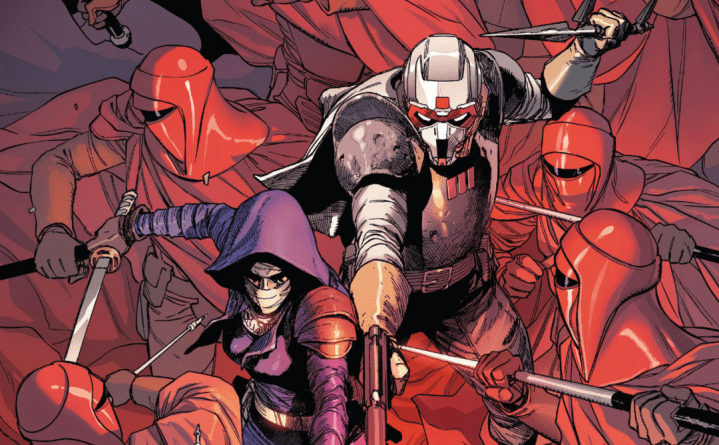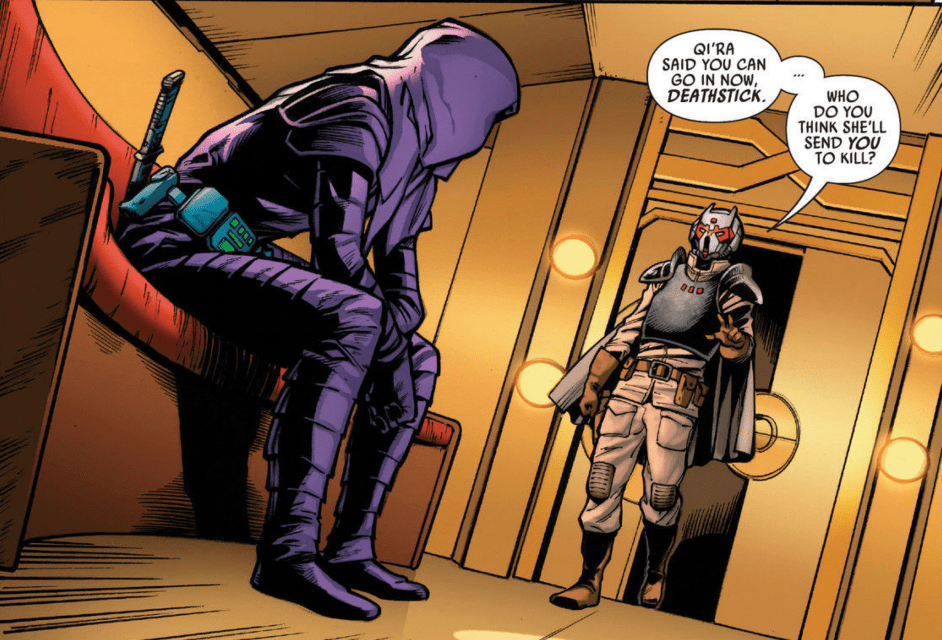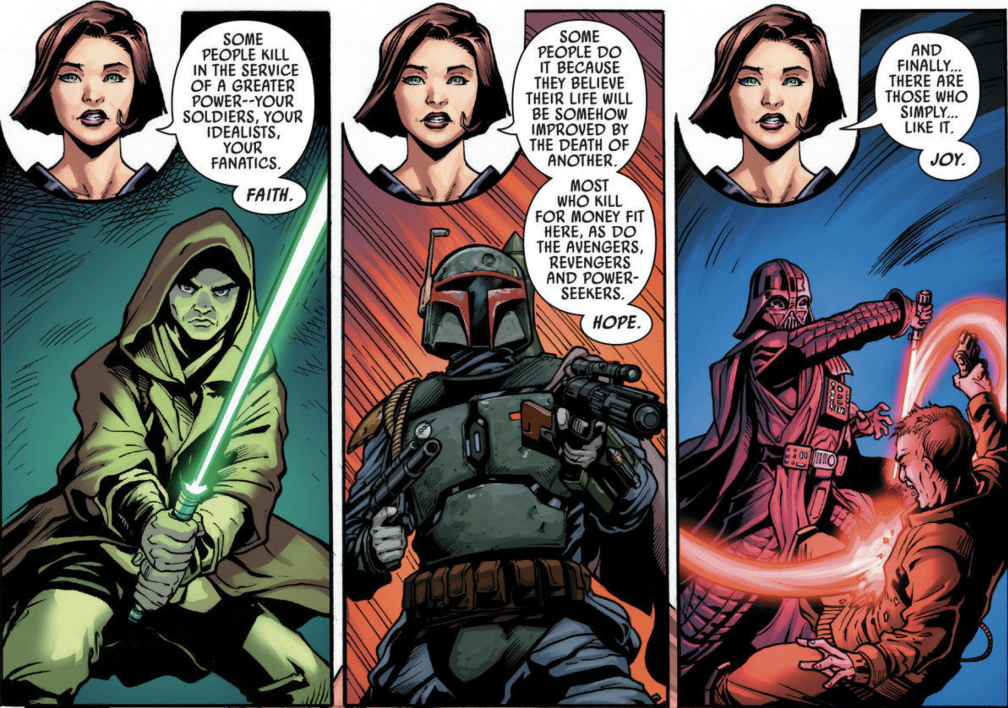
The second issue of Charles Soule’s Crimson Reign miniseries focuses on the two assassins, Ochi and Deathstick, who carry out some missions that fit into Qi’ra’s larger plans.
The five-issue series is illustrated by Steven Cummings and Victor Olazaba, and both the storytelling and the artwork are superb. Though this second issue wasn’t exceptional, it does set up some things and give some sayings to think on. Let’s dive into a review of the second issue!
SUMMARY:

The issue begins with the Archivist saying that Qi’ra’s biggest tool is deception, telling stories and lying to everyone, including herself, where useful. But sometimes she relied on truth instead, the truth that death awaits for all, and so she turned to assassins to carry it out The issue then focuses on the two assassins that are allied with Crimson Dawn, Ochi of Bestoon and the Nightsister Deathstick, and Qi’ra gives both of them targets to kill. Once they leave, she explains to her advisors how different killers are motivated by different things, and knowing what motivates them is the key to utilizing them. She says that Ochi is motivated by fear, so killing is a way to eliminate others who could kill him instead. She says that Deathstick is motivated by her feeling alone, after having seen her people eliminated by General Grievous during the Clone Wars, so she wants others to be alone too, having believed the lie that it will make her feel better.
Ochi is sent to Coruscant, where he secures very precise poison and sends a droid to discretely give it to a group of Palpatine’s Royal Guards before they go on duty. Knowing the precise timing of the poison allows him to plan carefully, and the poison takes affect at the very moment that Palpatine and Mas Amedda walk into the Throne Room in the Imperial Palace. All of the guards fall dead, with Qi’ra’s goal being to strike a bit of fear into Palpatine that he had instilled in the rest of the galaxy.
Deathstick, meanwhile, is sent to kill Cadeliah, a young girl who has close ties to both the Unbroken Clan and the Mourner’s Wail Syndicate, and who is hiding out amongst a group of rebels. As the Empire shows up and attacks the rebels, Deathstick quickly defeats and captures Cadeliah, bringing her back to Qi’ra. Deathstick inquires as to what Qi’ra wants with her, but the Crimson Dawn leader responds only that the girl’s fate belongs to her and tells Cadeliah that they will be good friends.
REVIEW:

This was a fine issue; although I didn’t feel like there was anything major that was revealed, it does seem to be setting up where Qi’ra’s plans could go from here.
The main aspect of Qi’ra’s plan is why she sends Ochi and Deathstick after their targets. Ochi’s target is relatively straightforward, as he’s sent to kill the Emperor’s Royal Guards and to do so in a way that is designed to inflict the maximum amount of fear in Palpatine. It’s intended to teach him that even in his throne room on Coruscant, he’s not safe – his guards die in that very room, right in front of him. Though he doesn’t know that Crimson Dawn is responsible (at least we don’t think he does), he’s supposed to fear an unknown enemy who can strike so much at the heart of the Empire. Deathstick’s target is much murkier as to what Qi’ra wants. Cadeliah is probably unknown to many readers of this comic, which adds to the confusion; she first appeared in the Bounty Hunters comic, but I think the most pertinent detail is that she’s the heir to two different crime syndicates. That’s why Qi’ra wants her, but we don’t know anything beyond that – although I suspect that perhaps Qi’ra views this as either a way to unite them or turn them against each other. We’ll have to wait and see which one (I’m guessing the former).
That’s the bulk of the issue, so there’s really no major reveals . There certainly doesn’t need to be a big reveal for a story to work, but in a five-issue miniseries you’re looking to see how this advances the story, and I don’t think we can really tell right now. Once we know how this story ends I think we’ll be in a better position to see how this particular issue fits into it. But there is one fun easter egg that’s included here, and it’s that Major Deez shows up as a Royal Guard! He appeared in the novel Lords of the Sith as he accompanied Palpatine and Vader to Ryloth. He’s one of the Royal Guards whom Ochi poisons while they are getting ready, and he dies along with the rest of his squad in the throne room. The fact that Charles Soule brought him into this issue and used him here is a fun connection to that novel, and it gives added depth beyond this just being an unknown, nameless character. I appreciated that tie.
And I also appreciated Qi’ra’s reflections on why people kill, because she is right that “everyone kills under the right circumstances.” She explains that some kill for faith, doing so in service of a greater power – and we see an image of a Jedi to illustrate this. She says that some kill for hope, as they hope that their lives will be improved by another’s death – and we see an image of a bounty hunter to illustrate this. And she says that some kill for joy, because they just enjoy killing – and we see an image of Darth Vader to illustrate this. In this, Qi’ra is touching on a very important theme within Star Wars. The reality is that everyone in the franchise kills others, whether good guys or bad guys. This makes the lines murky and muddled, because we could see both heroes and villains doing the same action. What differentiates them is the motivation for doing so. For example, Jedi are protectors of life and try to avoid taking life if at all possible – so when they kill, it’s because that’s the best way to protect life (in their view). But you contrast that with Vader, for instance, who takes joy in killing others. Or you contrast it with bounty hunters, who kill for work more than anything else, but even they are motivated by something – and Qi’ra says that they’re hoping their lives will be improved by what they do.
Taking life is never good and never the ideal, but everyone in the franchise is confronted with times where they do – and what makes the difference between the heroes and the villains is the motivations for doing so. And Qi’ra is touching on that, and I think Star Wars fans would do well to reflect on this and ponder on what she’s teaching. There is a concerning segment of the fandom that glorifies violence, almost enjoying seeing Anakin killing younglings or things like that, thinking that Star Wars needs to be “dark” (whatever that means), but all the while misunderstanding the very lessons that the saga is trying to instill. There’s a reason the Jedi are not warriors, and there’s a reason that almost always when we see them killing it’s portrayed as a bad thing. Anakin killing the villainous Sith apprentice is a key part of his descent to the dark side; Luke sparing the villainous Sith apprentice is a key part of his becoming a true Jedi.
Anyway, I found Qi’ra’s take on this insightful and thought-provoking, and I thought that was the most lasting takeaway from this issue, at least for now. But the rest of it does set up some elements of Qi’ra’s larger plan, and I think it will become more significant once we see some of the payoff in the coming issues.